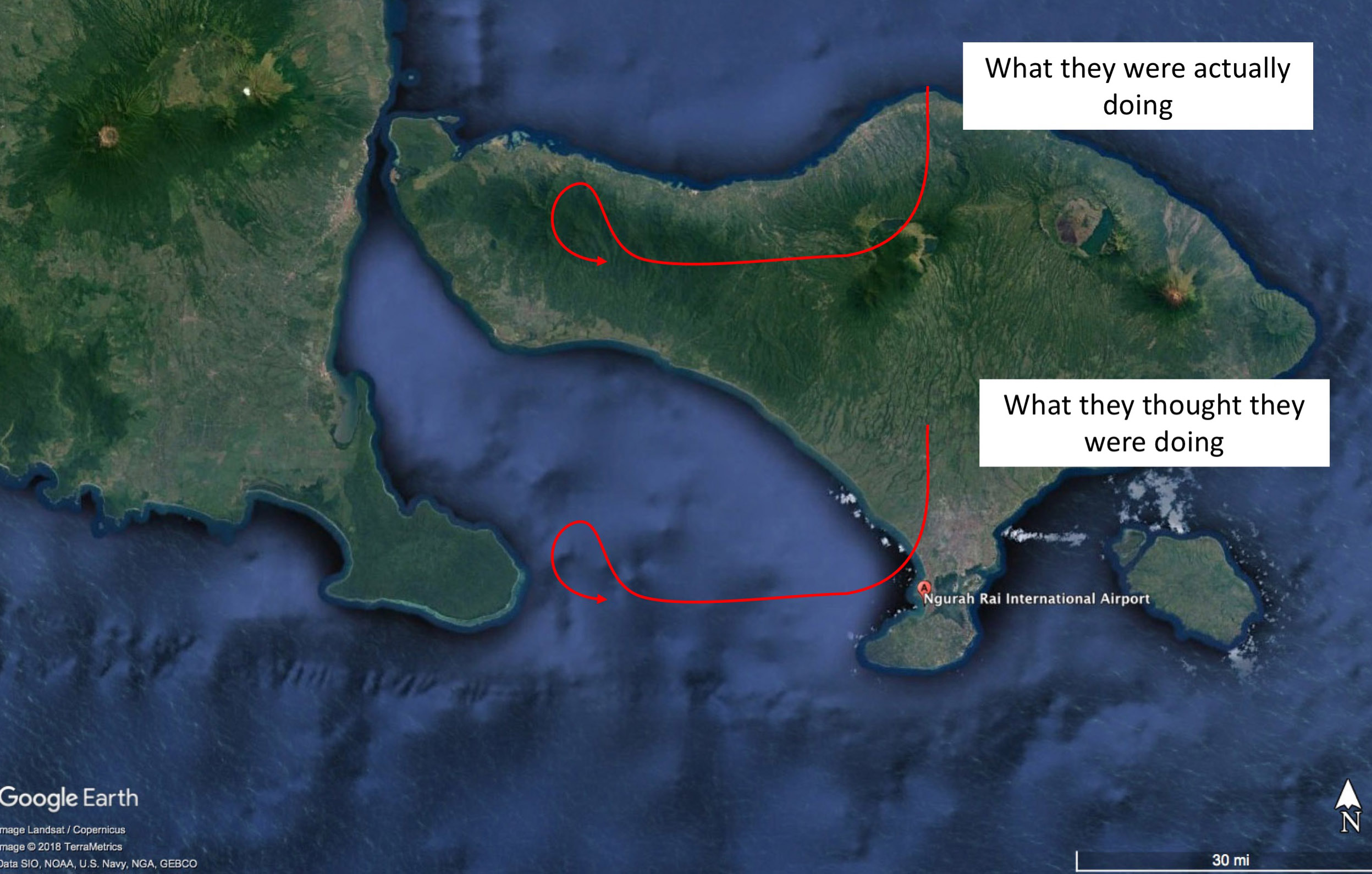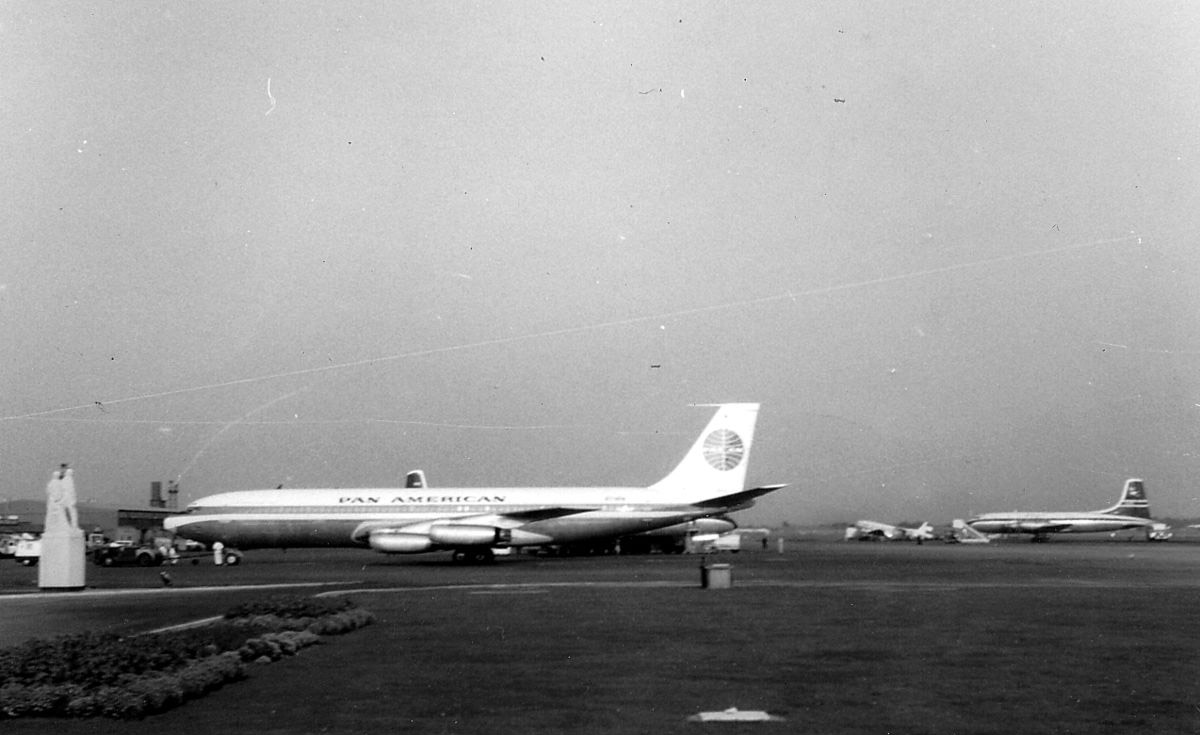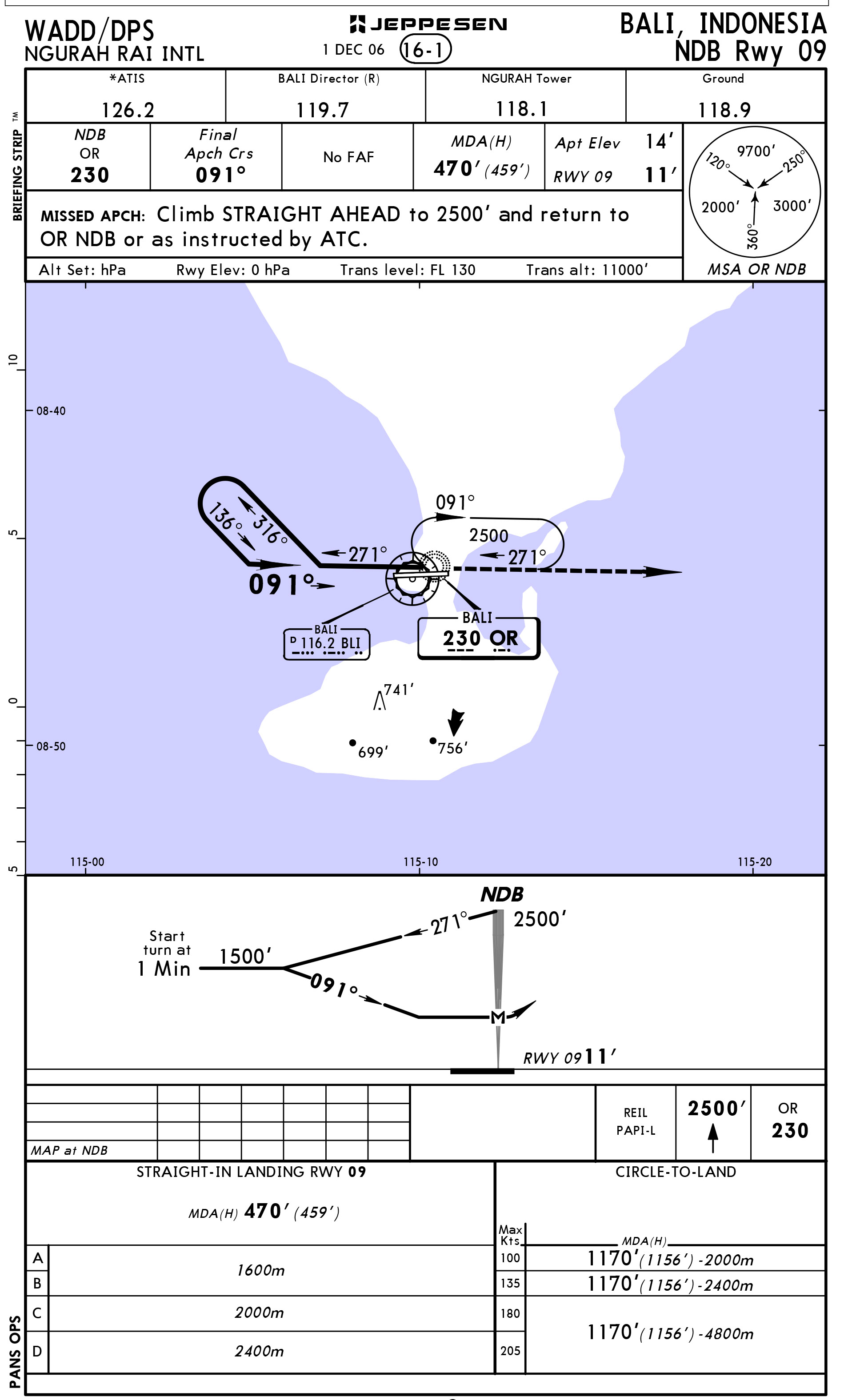On the surface, this seems to be a case of a poorly flown instrument procedure or perhaps just a misunderstanding of the sporadic nature of non-directional beacons. But there is much more to it than that.
— James Albright

Updated:
2018-02-01
This was the thirteenth incident in a series of 13, 11 of which pointed to a problem with the Crew Resource Management at Pan American World Airways at the time. This was the "straw that broke the camel's back," in that the FAA finally took action: (from Gandt, p. 116)
The FAA's findings confirmed the dismal facts that the internal Operations Review Group had already determined: Pan Am was crashing airplanes at three times the average rate of the United States airlines. Worse, Pan Am's accident rate was on the rise, a reverse of the steadily decreasing industry-wide accident experience with jet airliners. The report was scathing. Pan Am's accidents in the Pacific, declared the FAA, involved "substandard airmen." Training was inadequate, and there was a lack of standardization among crews. [ . . . ] But at the heart of Pan Am's troubles, according to the FAA, were human factors. [ . . . ] When applied to airline cockpits, it had the same taint as pilot error.
Pan American World Airways had no choice but to clean house and examine the way they flew airplanes. They were able to reverse their company culture and became one of the safest airlines in the world.

1
Accident report
- Date: 22 April 1974
- Time: 22:26
- Type: Boeing 707-321B
- Operator: Pan American World Airways
- Registration: N446PA
- Fatalities: 11 of 11 crew, 96 of 96 passengers
- Aircraft fate: Destroyed
- Phase: Approach
- Airport (departure): Hong Kong-Kai Tek International Airport (VHHH), Hong Kong
- Airport (arrival): Denspasar-Ngurah Bali International Airport (WADD), Indonesia
2
Narrative
The flight was arriving from the north, navigating to Bali by heading directly to a Non-Directional Beacon (NDB) while not under radar contact by anyone. It was up to them to find the beacon using two Automatic Direction Finder (ADF) radio receivers.
In the days before GPS, there were parts of the world where using an NDB was the only choice and pilots learned to treat the ADF needle with a great deal of skepticism. The needle was rarely steady and was known to point to the nearest power source, to be fooled by the local topography, or sometimes just point in increments of 40° for no known reason.
I had the misfortune of having to fly in many locations where the NDB was the only choice, but the good fortune to always have either a navigator or inertial navigation system to give me some confirmation of that pesky needle.
You cannot understand what happened to Pan Am 816 unless you understand just how unreliable an NDB can be. See: Non-Directional Beacon.
Note: the approach plate shown is the only one I have for the Bali NDB Runway 09, this one was published 30 years after the crash. But we aren't concerned with the niceties of the approach, the crew missed the runway by 30 nautical miles. What we are interested in is basic instrument procedures.
- Flight PA-812 was a scheduled international flight from Hong Kong to Sydney with an intermediate stop at Denpasar, Bali. The aircraft took off from Hong Kong at 1108 hours [GMT] on an IFR flight plan via A-83 GYM B-67 BTT B-91 GPR B-61 VJN and Denpasar with an estimated en-route time between Hong Kong and Denpasar (Bali) of 4:23 hours.
- Flight PA-812 was allocated flight level 330 from Hong Kong until BTT and thence proceeded at flight level 350 until Denpasar. The flight proceeded normally and position reports while in Indonesian UIR were carried out through Jakarta Radio on frequency 5673 kHz.
- At 1428 PA-812 was cleared by Jakarta Area Control Centre to descend to flight level 280. PA-812 established its first contact with Bali Tower at 1506 through Tower Frequency 118.1 MHz and was instructed by Tower to contact Bali control on frequency 128.3 kHz.
- At 1508 PA-812 informed Bali Control of revised ETA 1527. A clearance to descend to flight level 100 was given by Bali Control and at 1509 a request was made by the aircraft for active runway. Runway in use 09 was passed on by Bali Control to the aircraft.
- During descent to flight level 120, after observing that one of the ADF needles swung, at 1519, PA-812 reported over the station turning outbound and was subsequently instructed to contact Bali Tower. Twenty-five seconds later PA-812 established contact with Bali Tower informing outbound procedure, followed by a request for lower altitude.
Source: ICAO Circular 132-AN/83. No. 13, ¶1.1
The weather was reported to be cloudless, "the stars were bright and it was moonless." Under those conditions, many island destinations are almost impossible to see at night. I can't imagine any pilot with experience flying in this part of the Pacific would bet his life on one ADF needle while the other is rock steady in the other direction.
- Clearance was then given to descend to 2,500 ft and PA-812 was instructed to report reaching 2,500. At 1523 the aircraft reported reaching 2,500 ft and Bali Tower gave instructions to continue approach and to report when runway was in sight. Acknowledgment was made by PA-812 by saying "Check inbound". At 1526 the pilot-in-command requested the visibility by calling "Hey -Tower, what is your visibility out there now?".
- However, according to the transcription of Air Traffic Control voice recorder this message was never received by Bali Tower. Apparently this was the last message transmitted by the aircraft. Bali Tower kept trying to contact the aircraft by calling "Clipper eight one two, Bali Tower" and "Clipper eight one two, Bali Tower, how do you read" several times. However, no answer was received from the aircraft. It was subsequently found that the aircraft hit a mountain approximately 37 NM North-West of Ngurah Rai Airport, Bali.
Source: ICAO Circular 132-AN/83. No. 13, ¶1.1
3
Analysis
The report notes that the first ADF needle made its swing about 30 nm north of the airport, convincing the pilots it was turn to turn right for the course reversal (procedure turn). The report doesn't mention that there happens to be a 4,100 ft mountain there. Perhaps that had something to do with the premature ADF needle swing. But even if it didn't, given the mountainous terrain, the pilots shouldn't have elected to start their turn and descent based on one, unsteady needle.

Pan Am 812 ground track, (My reconstruction using the ICAO Circular description and GoogleEarth)
- According to the meteorological report for take-off and landing made by the meteorological officer at Bali Airport at 1500, the surface weather at Bali Airport was as follows: Surface wind: 11/5 kt., Horizontal visibility: 8 NM., Cloud: 1 Oktas Cu 2,000 ft.
- According to eyewitness observations, the weather at the accident site was clear (cloudless), the stars were bright and it was moonless.
Source: ICAO Circular 132-AN/83. No. 13, ¶1.7
- Examination on the disposition of the wreckage and inspection of the site indicated that no structural failure of the aircraft occurred before impact. No indication of any malfunctioning of engines or break up prior to impact of the aircraft with the ground was found. The Board did not find any evidence that may indicate that the aircraft was not in an airworthy condition at the time of the accident. Examination of the cockpit voice recorder revealed that the pilot-in-command of the aircraft experienced some difficulties in establishing contact with Bali Air Traffic Control. First contact between the aircraft and Bali Tower was established at 1506 whereupon Bali Tower instructed PA-812 to contact Bali Control on frequency 128.3 MHz, because the aircraft was still within the jurisdiction area of Bali Control. This was acknowledged by PA-812 accordingly. Subsequently communication between the aircraft and the ground was normal.
- The cockpit voice recorder further disclosed that the pilot-in-command had encountered no difficulty with the procedures to land at Bali Airport, in which it was mentioned to maintain at 12,000 ft until the beacon and then to execute the full ADF let-down procedure. The cockpit voice recorder also disclosed that the pilots were aware of the existence of a 7,500 ft mountain 26 miles North of Bali Airport, another 10,000 ft mountain north-north-east of the airport and that flight level 120 would clear them from the mountains mentioned above. From the conversation amongst flight crew members it was further disclosed that the estimated time of arrival was 1527, which was subsequently passed to Bali Control. It was further disclosed that the pilot intended to make a right hand turn within 25 miles from the beacon for a track out on 263 degrees, descending to 1,500 ft followed by a procedure turn over the water for final approach on Runway 09 which was the runway in use given by Bali Control.
- As recorded by the cockpit voice recorder at approximately 1518 the crew observed that ADF number one was swinging while ADF number two remained steady. A few seconds later at 1519 PA-812 reported to Bali Control that he was over the station turning outbound descending to flight level 120. This was acknowledged by Bali Control and PA-812 was then instructed to change over to Bali Tower. Having established contact with Bali Tower, PA-812 reported making outbound procedure flight level 110 and requested lower altitude. Clearance was given by Bali Tower to descend to 2,500 ft, with instructions to report at that height. At 1523 PA-812 reported reaching 2,500 ft.
- The Board is of the opinion that the crew in an attempt to expedite their approach into Bali Airport, elected to execute an early right hand turn for track out on 263 degrees. By using this type of approach they were prevented from knowing their exact position. Such an early turn would necessitate the pilot's obtaining an early indication on the ADF that the was nearing the NDB. Evidently the right hand turn was made at the time when only one of the ADF needles swung. According to the reconstruction of the flight path, based on information obtained from the flight recorder, it is evident that the right hand turn was made at a position approximately 30 NM North of the beacon.
- Although several attempts were made to regain proper indication on the ADFs after the turn, the Board believes that this would not have been possible since the aircraft would be shielded by the mountain range. However, the approach was continued as planned resulting in a collision with high ground.
- The flight data recorder and cockpit voice recorder read-outs revealed no evidence of any aircraft abnormality during any part of the flight prior to the accident.
Source: ICAO Circular 132-AN/83. No. 13, ¶2.1
4
Cause
The official "cause" listed by the report would have failed basic the accident investigation report writing I learned at the USAF flight safety officer course. The report says the crash was caused by a premature turn. No, the crash was caused by an airline's culture that (a) permitted the captain to fly with inadequate training and oversight (which led him to the premature turn), and (b) discouraged cockpit crewmembers from actively watching the captain for these kinds of mistakes.
The Board determined that the probable cause of this accident was the premature execution of a right hand turn to join the 263 degrees outbound track which was based on the indication given by only one of the ADFs while the other one was still in steady condition.
Source: ICAO Circular 132-AN/83. No. 13, ¶2.2 b)
References
(Source material)
Gandt, Robert, Skygods: The Fall of Pan Am, 2012, Wm. Morrow Company, Inc., New York
ICAO Circular 1977, 132-AN/93, Aircraft Accident Digest No. 21, ICAO, Montreal, Canada

